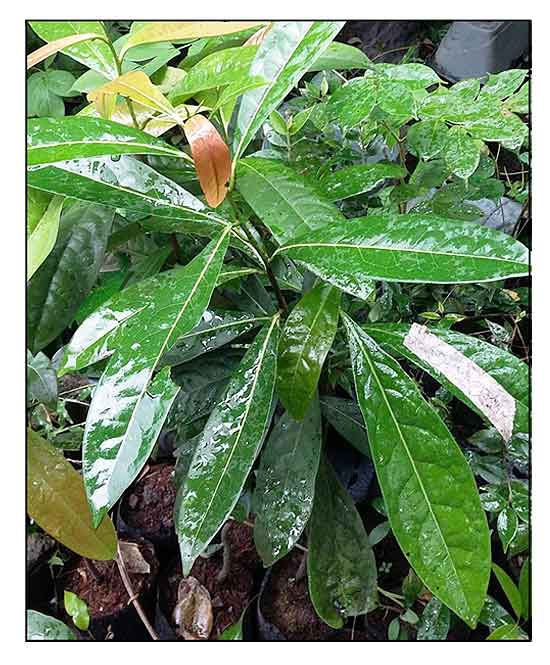 Gen info Gen info
- Diospyros is a genus of over 700 species of deciduous and evergreen trees and shrubs. The majority are native to the tropics. Some are known for their hard and heavy timber, called ebony trees; others are valued for their fruits, known as persimmon trees. (5)
- Etymology:The genus name Diospyros derives Greek words dios and pyros; the Greek name literally means "Zeus's wheat" or "divine food" or "divine fruit".
- The oldest fossils of the genus date to the Eocene period
(the second epoch of the Tertiary period, between Paeocene and Oligocene epochs).
Botany
Diospyros curranii is an evergreen tree, up to 10 m high, twigs unarmed. Leaves (oblong-) obovate, 7–15 by 2.5–4.5 cm, base acute or slightly cuneate, apex acuminate, cuspidate with blunt point, coriaceous, glabrous on both surfaces; midrib always orange when dry, secondary nerves 8–12 pairs, faintly anastomosing well away from the margin, inconspicuous on both surfaces; reticulation prominent on upper surface, inconspicuous on lower surface; petiole ± 3 mm long, glabrous. Male flowers cymose, 4(–5)-merous; pedicel 2–3 mm long, pubescent. Calyx campanulate, 2–4 mm long, divided to middle; pubescent outside, ± glabrous inside. Corolla urceolate or ovoid, 4–7 mm long, divided to middle, pubescent outside, glabrous inside. Stamens 16–18, glabrous. Rudimentary ovary hirsute. Female flowers solitary or cymose, 4(–5)-merous; pedicel ± 2 mm long, pubescent. Calyx campanulate, divided to the base, glabrous on both sides. Corolla ovoid, divided to the base, pubescent outside, glabrous inside. Ovary ovoid, tomentose, 4-locular; style single, tomentose. Staminodes 8–10, glabrous. Fruit globose, ca 2 cm diam. pericarp crustaceous, glabrous, base rounded or ± depressed, apex rounded with short cusp; fruiting calyx divided ± to the base, ± glabrous on both sides, lobes (apex) ascending, but margin reflexed, undulate and ± plicate, with inconspicuous nerves; fruit-stalk 5–10 mm long; endosperm smooth. (Flora of Thailand) (4)
Distribution
- Native to the Philippines.
- Also native to Borneo, Cambodia, Laos, Malaya, Sumatera, Thailand.
- Grows primarily in wet tropical biome.
(2)
- In low and medium elevation primary forests, up to 400 m.
Constituents
- Roots have yielded bioactive compounds cholestanol, stigmasterol, and friedelin. (see study below) (7)
Properties
- Study has suggested antibacterial properties.
Parts used
Stems, roots.
Uses
Edibility
- No information found on fruit edibility.
Folkloric
- No reported folkloric medicinal use in the Philippines.
- In Thailand, stems used for treatment of abscesses and edema. (8)
Others
- Wood: Harvested from the wild for its high quality wood. Wood is hard to very hard; sapwood is tough; the heartwood, brittle. Small trees with little or no heartwood used for posts, beams, joists, rafters, window sills, agricultural implements, etc. Heartwood used for scabbards, canes, hilts, tool handles, gunstocks, saw frames, guitar keys, paper weight, etc. (6)
Studies
• Friedlin / Antibacterial Synergism with Ampicillin / Root: Study evaluated the synergistic effect of friedelin, isolated from hexane extract or D. curranii root with ampicillin against opportunistic gram(-) bacteria E. coli, Acinetobacter baumannii and P. aeruginosa. MICs of ampicillin against all bacterial isolates were 256 to 512 µM and 512 to 1024 µM, respectively. Synergistic effect was greater compared to individual drug. Best synergism was against E. coli ATCC 25913 with FIC of 0.25. (3)
• Antibacterial / Cholestanol, Stigmasterol, Friedelin / Root: Study evaluated the effect of bioactive compounds cholestanol, stigmasterol, and friedelin from roots of D. curranii and compared with the antibacterial activity of ampicillin and tetracycline against gram negative opportunistic bacteria Acinetobacter baumannii, E. Coli 25913 and P. aeruginosa. Results showed the pure compounds could inhibit the growth of some opportunistic infections with stigmasterol showing best MIC of 128 µM. Friedelin could inhibited E. coli, A. baumannii, and P. aeruginosa with MICs of 512m 256 and 1024 µM, respectively. Compared to the antibiotics, friedelin showed best antibacterial activity. (7)
Availability
Wild-crafted.
|

![]()



 Gen info
Gen info